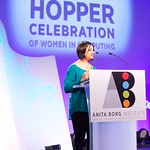Saturday morning, while most people slept in after a Friday night out, the researchers at the Institute of Quantum Computing (IQC) were setting up for their all-important open house. It was a sunny morning and a fine day for some of the brightest minds on campus to congregate at the Research Advancement Center (RAC and RAC2) in the Research and Technology Park.
Founded in 2002, the mission of the Institute for Quantum Computing (IQC) is to “aggressively explore and advance the application of quantum mechanical systems to a vast array of relevant information processing techniques.” The IQC holds an open house every year to improve their relations with the people of the Waterloo area. According to Colin Hunter, Communications Specialist, “Waterloo has the most inquisitive population and the people are highly inclined towards academia.” IQC’s open house is meant as an outreach program to connect with people. According to Sean Collins, Network Manager at QuantumWorks, Canada is the world leader in quantum information processing. QuantumWorks is an affiliate of the IQC and serves as a co-ordinator in quantum computing research all over Canada. It is responsible for facilitating cooperation between researchers and funding research in quantum information processing. As a result, many of the world’s leading minds in quantum research have joined the IQC. Recently, Dr. David Cory, formerly a leader in quantum computing at Massachusetts Institute of Technology, has also joined the IQC.
As soon as visitors entered, they were greeted by delicious treats to prepare them for the mind-intensive day ahead. The Discovery Center, aimed at children, had all the classic science fair experiments, but with a twist. There was fresh ice cream made from liquid nitrogen, superconductors, levitating magnets and best of all, a train that started to run when fuelled with liquid nitrogen. Additionally, there were a variety of experiments to illustrate the basic principle of computing.
As visitors came down to the second floor, there were various experiments from data encryption and application of quantum physics theory, to standard data processing. There was the “Alice and Bob System” for information transmitting. Polarized light beams are used to transmit information from the RAC to the EIT and then to the Perimeter Institute. The obtained data is then analysed through the principles of quantum computing and probability to check the data for integrity. There were a variety of experiments on display to illustrate data encryption and checking for data integrity. Similar systems have been in place for data transmission over fibre optic to ensure highest security of data and preventing unregulated snooping of the data.
The main floor had all the extreme experiments. There were experiments using nuclear resonance for controlling the resonance of certain atoms. They use the different orientations of a molecule to store data as 1s and 0s. There were more experiments related to Electron Spin Resonance (ESR) which used the spin of an electron to store data. There were highly sensitive one-photon-sensing systems. There were systems that brought the temperature of a sample to about 15mK. There were also systems that produced InGaAs (Indium Galium Arsenide) quantum dots quickly and efficiently on a microscopic scale. Additionally, all the systems were produced on-site and offer a large range of customizability. One of the innovative researchers has custom built a program to control one of the systems using a mobile if necessary. The IQC also houses a grade 1000 clean room for the fabrication of their highly sensitive devices. The clean room houses state of the art facilities such as Electron Beam Lithography and other similar processes.
The highlight of the day was the public lecture by Dr. David Cory. Overall, the IQC open house was enlightening. Granted, a lot of the core research is way beyond the understanding of an average person, but the sight of all the fancy equipment is enough to make you stand and stare in awe. These applications have a large scope and many of these technologies are already being used. One of the leading news journals once carried an article about a quantum information computing system being cracked by one the researchers collaborating with QuantumWorks.




Leave a Reply